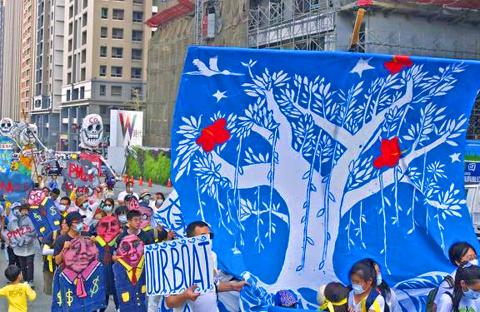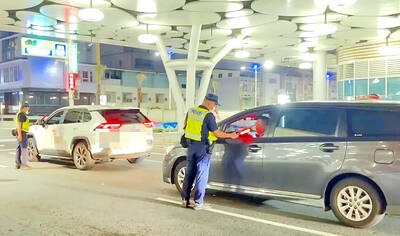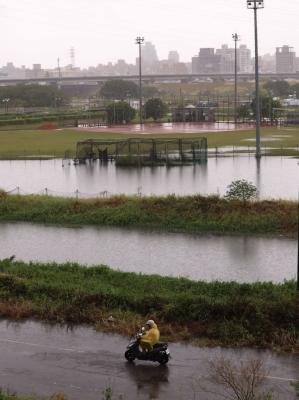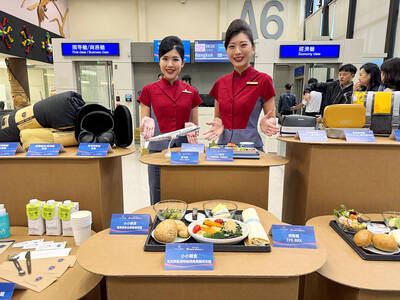Protesters yesterday staged a demonstration at the Central Taiwan Science Park in Taichung, demanding the immediate suspension of an expansion project for the park, which they said would aggravate air pollution and pose greater health risks.
Protesters and 41 environmental groups called for the suspension of the project and an overhaul of national development policies, saying that more than 20 percent of the nation’s science parks and industrial zones are underutilized, with the government not making good use of idle plots while rezoning a forest for the Taichung science park expansion.
The expansion was mainly based on a Taiwan Semiconductor Manufacturing Co (TSMC) project to build an 18-inch wafer plant on Dadu Mountain in Situn (西屯) and Daya (大雅) districts, with the plan passing an environmental impact assessment in February.

Photo: Tsai Shu-yuan, Taipei Times
Taichung-based environmentalist Tsai Chih-hao (蔡智豪) said the TSMC plan did not assess health risks in association with many carcinogenic pollutants, calling for an end to construction until proper assessments are completed.
Tsai demanded an apology from Taichung Mayor Lin Chia-lung (林佳龍) for Lin’s part in soliciting TSMC investment, which Tsai said put city residents at risk of pollution-related illness, adding that the number of adenocarcinomas of the lung — a major type of lung cancer — in the area has risen to become the highest rate in the nation due to the city’s deteriorating air quality.
Impersonating the mayor, Taiwan Healthy Air Action Alliance founder Yeh Guang-peng (葉光芃) delivered a mock apology, saying that Lin in 2012 pledged to remove highly polluting and energy-intensive industries from the city to reduce air pollution and bring back blue skies.
Instead of blue sky, PM2.5 — airborne pollutants measuring 25 micrometers or less in diameter — is Lin’s legacy, Yeh said.
Taichung Veterans General Hospital respiratory physician Hsu Cheng-yuan (許正園) said each 10 microgram per cubic meter rise in PM2.5 is associated with an 8 percent increased risk of lung cancer morbidity, which, in terms of the population of Taichung, could lead to 220,000 residents being affected by the disease.
In a letter to TSMC chairman Morris Chang (張忠謀), who on Thursday said that power shortages and protests from environmentalists were the two major uncertainties for future investment in Taiwan, protesters said government-subsidized electricity for industrial development has cost the nation its environment and health, while residents and even TSMC employees, in addition to environmentalists, were among the protesters.
TSMC contributes to the condition of the sky and poisonous air in central Taiwan, the letter said.
Clean rooms in the company’s factories might be the only place where people could breathe clean air, it said, calling on the company to fulfill its corporate responsibility.
Protesters said they would be collecting signatures to launch a referendum on whether the expansion project should be discontinued.

TRAFFIC SAFETY RULES: A positive result in a drug test would result in a two-year license suspension for the driver and vehicle, and a fine of up to NT$180,000 The Ministry of Transportation and Communications is to authorize police to conduct roadside saliva tests by the end of the year to deter people from driving while under the influence of narcotics, it said yesterday. The ministry last month unveiled a draft of amended regulations governing traffic safety rules and penalties, which included provisions empowering police to conduct mandatory saliva tests on drivers. While currently rules authorize police to use oral fluid testing kits for signs of drug use, they do not establish penalties for noncompliance or operating procedures for officers to follow, the ministry said. The proposed changes to the regulations require

The Executive Yuan yesterday announced that registration for a one-time universal NT$10,000 cash handout to help people in Taiwan survive US tariffs and inflation would start on Nov. 5, with payouts available as early as Nov. 12. Who is eligible for the handout? Registered Taiwanese nationals are eligible, including those born in Taiwan before April 30 next year with a birth certificate. Non-registered nationals with residence permits, foreign permanent residents and foreign spouses of Taiwanese citizens with residence permits also qualify for the handouts. For people who meet the eligibility requirements, but passed away between yesterday and April 30 next year, surviving family members

Taipei, New Taipei City, Keelung and Taoyuan would issue a decision at 8pm on whether to cancel work and school tomorrow due to forecasted heavy rain, Keelung Mayor Hsieh Kuo-liang (謝國樑) said today. Hsieh told reporters that absent some pressing reason, the four northern cities would announce the decision jointly at 8pm. Keelung is expected to receive between 300mm and 490mm of rain in the period from 2pm today through 2pm tomorrow, Central Weather Administration data showed. Keelung City Government regulations stipulate that school and work can be canceled if rain totals in mountainous or low-elevation areas are forecast to exceed 350mm in

China Airlines Ltd (CAL) yesterday morning joined SkyTeam’s Aviation Challenge for the fourth time, operating a demonstration flight for “net zero carbon emissions” from Taiwan Taoyuan International Airport to Bangkok. The flight used sustainable aviation fuel (SAF) at a ratio of up to 40 percent, the highest proportion CAL has achieved to date, the nation’s largest carrier said. Since April, SAF has become available to Taiwanese international carriers at Taipei International Airport (Songshan airport), Kaohsiung International Airport and Taoyuan airport. In previous challenges, CAL operated “net zero carbon emission flights” to Singapore and Japan. At a ceremony at Taoyuan airport, China Airlines chief sustainability